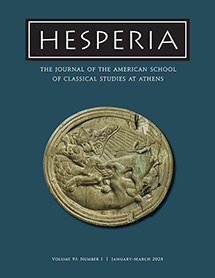Hesperia 93.1 Now Online!

We are pleased to announce the publication of Hesperia 93.1! Topics in this issue include an exploration of an ivory pyxis lid from the grave of the Griffin Warrior at Pylos, a survey of modern scholarship on Hellenistic Athenian taxes and tax administration, an investigation of artifact densities in the western Argolid, and a detailed look into the provenance and transmission of a Tang Dynasty coin found in a Frankish-period deposit at Corinth.
Subscribers can read the issue online at Project MUSE, which now hosts current issues of Hesperia as well as an archive of past volumes dating to 2002. Hesperia remains on JSTOR as part of their Arts and Sciences II package, with the usual three-year moving wall. Additionally, all issues of Hesperia from 2011 and earlier are available as Open Access on our website. The printed version will be mailed shortly.
The Griffin and Lion Ivory Pyxis Lid from the Grave of the Griffin Warrior at Pylos, by Jack L. Davis, Sharon R. Stocker, and Joan Aruz, presents an exquisite ivory pyxis lid that was discovered in 2015 in the grave of the Griffin Warrior at Pylos. The lid, carved in high relief, depicts in great detail a combat in which a lion defeats a griffin. The modeling and carving of the ivory are of exceptional quality. Here, the authors first consider the specific context and circumstances of the discovery of the lid—the final find removed from the grave—before turning to a discussion of precedents and parallels for its motifs and theme. Finally, they consider the possibility that a scene of a lion victorious over a griffin had particular significance at Pylos, in light of relations between Messenia and Neopalatial Crete in the Late Helladic IIA period.
Athenian Taxes in the Hellenistic Period, by Peter Fawcett, surveys modern scholarship on Athenian taxes and tax administration in the Hellenistic period, from the death of Alexander the Great to the sack of Athens by the Romans in 86 BCE, and on the benefits that Athens derived from the tax-free island of Delos after 167 bce. The article highlights the transition from compulsory to voluntary payments as taxes, and examines continuities and discontinuities in Athenian taxes from the Classical period to the Hellenistic period, as well as their influences on Roman taxes.
A Tang Dynasty Coin in 13th-Century Corinth: Context and Transmission, by Ching-Yuan Wu, examines a Tang Dynasty coin found at Corinth in an ash and charcoal layer with deposits from the mid- to late 13th century CE and earlier. Considering similar coin finds from the Xinjiang Uygur Autonomous Region, China, and the Chui Region, Kyrgyzstan, this article argues that the Corinth Tang coin is likely an Anxi Protectorate issue, though a Chui valley origin cannot be ruled out. This article discusses the origins, survival, and mobility of this minimal-value cash coin in a web of Eurasian connections, with particular focus on the connectivity of the Church of the East and the Jewish merchant network from the 8th to the 13th century CE.
Landscape Histories and Terrestrial Networks in the Peloponnese: Results from the Western Argolid Regional Project, by Sarah A. James, Dimitri Nakassis, William R. Caraher, Scott C. Gallimore, Grace Erny, Rachel Fernandez, Joseph Frankl, Alyssa Friedman, Melanie Godsey, and Machal Gradoz, describes the work of the Western Argolid Regional Project, an intensive pedestrian survey of 30 km2 located northwest of Argos along the banks of the Inachos River. Using high-intensity collection strategies, WARP generated very fine-resolution data that provide insights into the ways this seemingly marginal area contributed to and was impacted by regional histories. A key question is how the network of mountainous routes that traverse this landscape, connecting the area to the Corinthia and Arkadia, may have influenced localized, diachronic settlement patterns. This article focuses on areas of high artifact densities to demonstrate how regional activity and interconnectivity changed from the Neolithic to Modern period at this crossroads in the northeastern Peloponnese.
Click here to subscribe to Hesperia. In addition to receiving printed issues and online access to Hesperia, subscribers also receive complimentary online access to Hesperia Supplements, and Agora and Corinth volumes.
Hesperia welcomes submissions from scholars working on all aspects of Greek material culture, including archaeology, art, architecture, history, epigraphy, and related studies. Further information about the journal, including instructions for preparing manuscripts for submission, can be found on our website.
The Friends of Hesperia was founded in 2014 to help fund the journal's growth in all its manifestations. We invite you to become a member today and help support one of the most preeminent journals in the field of Mediterranean archaeology.